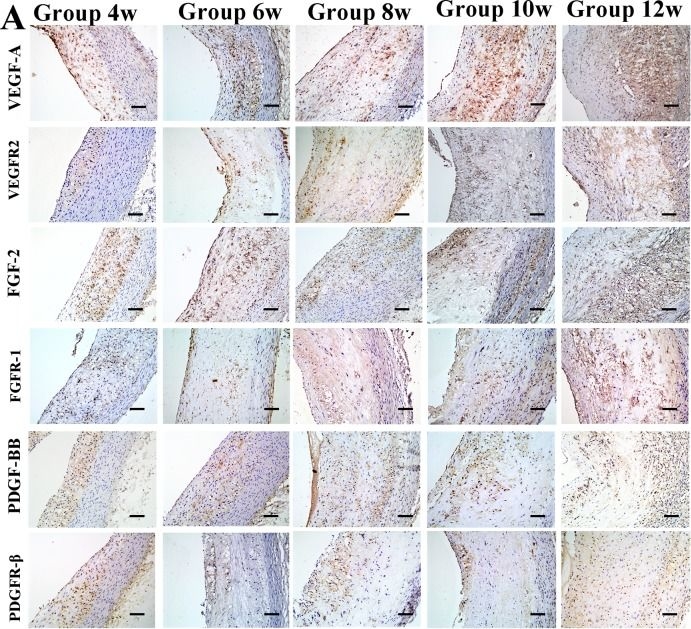Anti-Fibroblast Growth Factor Receptor 1α (FGFR1α) Antibody (30104)
Anti-Fibroblast Growth Factor Receptor 1α (FGFR1α) Antibody (30104)
Product No.: 30104
- -
- -
Clone M2F12 Target Fibroblast Growth Factor Receptor 1 (FGFR1) Formats AvailableView All Product Type Monoclonal Alternate Names FGFR-1, EC 2.7.10.1, Basic fibroblast growth factor receptor 1, BFGFR, bFGF-R-1, Fms-like tyrosine kinase 2, FLT-2, N-sam, Proto-oncogene c-Fgr, CD antigen CD331 Isotype Mouse IgG2a Applications FACS , IHC , IP , WB |
Data
 Immunohistochemistry
ImmunohistochemistryStaining of growth factors in aortic plaques from high cholesterol-fed rabbits. Protein expression of vascular endothelial growth factor A (VEGF-A), VEGF receptor 2 (VEGFR-2), basic fibroblast growth factor 2 (FGF-2), FGF receptor 1 (FGFR)-1, platelet-derived growth factor-BB (PDGF-BB) and PDGF receptor Beta (PDGFR-Beta). (Bars = 50 μm).
- -
- -
Antibody DetailsProduct DetailsReactive Species Human ⋅ Mouse ⋅ Rat Host Species Mouse Immunogen Recombinant human ectodomain of FGFr1a expressed in E. coli beginning with pro23; antigen contained NH2-terminal gly-ser-pro-gly-ile and COOH- terminal glu-phe sequences. Product Concentration Lot Specific Formulation PBS, pH 7.4 State of Matter Liquid Product Preparation Purified by Protein G affinity chromatography Storage and Handling These antibodies are stable for at least one (1) year at -20°C to -70°C. Store product in appropriate aliquots to avoid multiple freeze-thaw cycles. Country of Origin USA Shipping Next Day 2-8°C Applications and Recommended Usage? Quality Tested by Leinco Western blotting: at 1 ug/ml recognizes 10 ng recombinant bacterial, baculo-viral, or native FGFr1.
Immunoprecipitation: native, nuclear, recombinant, and ligand-labeled FGFr1. Immunohistochemistry: frozen sections of human glioblastomas, para-formaldehyde- fixed cells and nuclei, human myocardial biopsies. Each investigator should determine their own optimal working dilution for specific applications. See directions on lot specific datasheets, as information may periodically change. DescriptionDescriptionSpecificity Mouse Monoclonal Antibody specific to FGF Receptor-α. It reacts with the NH2-terminus of
unique NH2-terminal Ig loop of FGFr1.
Epitope is within the sequence between
glu30 and ala74 of FGFr1α. Reacts with
human, rat, and mouse receptor. Other
species untested. Background The fibroblast growth factor (FGF) family is a group of multi-functional polypeptides that function in embryonic development, tissue repair, neuronal cell survival, cardiovascular disease, and tumorigenesis. The biological activities of FGF are mediated by cell surface receptors that have tyrosine kinase activity. FGFR-1 is activated by FGF-1 and FGF-2. In neoplastic cells, overexpression of FGF-1, FGF-2 and FGF receptors appear to contribute to cellular trans- formation and proliferation. Function Tyrosine-protein kinase that acts as cell-surface receptor for fibroblast growth factors and plays an essential role in the regulation of embryonic development, cell proliferation, differentiation and migration. Required for normal mesoderm patterning and correct axial organization during embryonic development, normal skeletogenesis and normal development of the gonadotropin-releasing hormone (GnRH) neuronal system. Phosphorylates PLCG1, FRS2, GAB1 and SHB. Ligand binding leads to the activation of several signaling cascades. Activation of PLCG1 leads to the production of the cellular signaling molecules diacylglycerol and inositol 1,4,5-trisphosphate. Phosphorylation of FRS2 triggers recruitment of GRB2, GAB1, PIK3R1 and SOS1, and mediates activation of RAS, MAPK1/ERK2, MAPK3/ERK1 and the MAP kinase signaling pathway, as well as of the AKT1 signaling pathway. Promotes phosphorylation of SHC1, STAT1 and PTPN11/SHP2. In the nucleus, enhances RPS6KA1 and CREB1 activity and contributes to the regulation of transcription. FGFR1 signaling is down-regulated by IL17RD/SEF, and by FGFR1 ubiquitination, internalization and degradation. {UniProtKB:P16092, PubMed:10830168, PubMed:11353842, PubMed:12181353, PubMed:1379697, PubMed:1379698, PubMed:15117958, PubMed:16597617, PubMed:17311277, PubMed:17623664, PubMed:18480409, PubMed:19224897, PubMed:19261810, PubMed:19665973, PubMed:20133753, PubMed:20139426, PubMed:21765395, PubMed:8622701, PubMed:8663044}. NCBI Gene Bank ID UniProt.org Research Area Growth Factors, Cytokines, Receptors References & CitationsXu et al. (1992) J Biol Chem 267: 17792 Proudovsky et al. (1994) J Biol Chem 269: 31720 Morrison et al. (1994) Cancer Res 54: 2794 Zhao et al. (1994) J Clin Invest 94: 992 Feng et al. (1996) Biochim Biophys Acta 1310: 67. Mao, Y., Liu, X., et al.(2018) PLoS One.13(8):e0201395 Technical ProtocolsCertificate of Analysis |
Formats Available
- -
- -
Prod No. | Description |
|---|---|
30104 |
 Products are for research use only. Not for use in diagnostic or therapeutic procedures.
Products are for research use only. Not for use in diagnostic or therapeutic procedures.


